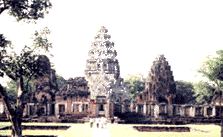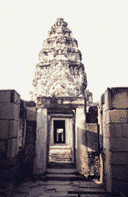

Prasat Hin Phimai, one of important religious sanctuary, is situated in the centre of ancient Phimai City in Nakorn Ratchasima, which is a gateway to the northeast of Thailand.
Prasat Hin Phimai was not only built as a sanctuary for both Buddhism and Hinduism but also for the worship of person, which is believed by the ancient native tribes such as Jam, Java, Bali and Khmer. They believed that a person who had built a sanctuary would be with Gods after their death.
To build Prasat was originated from the belief that Pra Sumeru Mount was a core of the Earth. The main Prasat was meant to be a centre. Surrounding wall represent the edges of the Universe. Ponds, next to the walls, represent the great oceans. Each level of Pra Sumeru Mount has Himapana creatures such as Garuda, Giant, angels and , also, Narayana and Siva.
The main Prasat, the core of Pra Sumeru Mount, was a place that kept the lingum or sacred images. These sacred images at Prasat Hin Phimi are believed to be Kamara Tenga Vimai, which is the most important sacred image of the Buddhist sanctuary mentioned in the inscription.
General characteristic of Prasat Hin Phimai
Prasat Hin Phimai is situated at the centre of Phimai city, which is at the bank of the river Moon. This large city located on a rich plateau called Tung Samrit where is an important area for producing rice. Prasat Hin Phimai is a chrming Mahayana Buddhist sanctuary. It has a cross-shaped plan and consists of 3 important buildings; the main Prang (tower), the prang Bhramadhat and Prang Hin Daeng. All prangs are surrounded by walls that are punetuated by gate-towers at four cardinal points; North, South, East and West. There are ponds at all four corners. The front gate of the Prasat is on the south. The main entrance is a bridge, which is decorated with Naga facing south.
Prasat Hin Phimai is, as aforementioned, a charming Mahayana Buddhist sanctuary. The main prang consists of a square building with portico at all four directions. Each portico is with carved Buddha images in styles described below.
-
South portico: Buddha image with Naga facing south
-
West Portico: Buddha image when he gave his sermon to the king of Mara (demon)
-
North portico: Buddha images in presence of 5 Vajirasattas (Bhodhisatta)
-
East portico: Ten Buddha images, dressed and in sitting position
The gables on four porticos are beautifully carved, described below;
-
The gable on the south portico: with scene of Siva is performing 108 postures of dancing. This scene is also called Sivanagaraj.
-
The gable on the west portico: with scenes of Krisana is lifting up Kovantana Mount and Ramayana is marking out the roads.
-
The gable on the North portico: with scenes of the fighting from Ramayana; Narayana with 4 hands.
-
The gable on the East portico:with scenes from Ramayana; King Malivaraj is pleading and prince Rama is killing Giant Viratha.
Prang Bhramadhat is on the left of the main Prang. It contains image of King Bhramadhat and lady Orapima.
Prang Hin daeng, a religious sanctuary, was built with red stones.
There are several important and interesting parts of Prasat Hin Phimai such as Pratu Chai (gate of victory), Klung Ngeon (a treasury) or Dhama Sala, a post for a ceremony to worship fire, Royal pavillion, a church for an ascetic, Church of King Phimai and Meru Bhramadaht.
Prasat Hin Phimai is an ancient Buddhist sanctuary that has been long standing for almost 2,000 years. It is believed that King Suriyavoraman I of Cambodia (1002-1050) built it. The prasat had been maintained until the reign of King Chaivoraman VII. It is also believed that, In the reign of King Suriyavoraman I, other prasats with the same age were also built. They are; Prasat Hin Panomwan (Panomwan temple, Nakorn Ratchasima) and Prasat Hin Panom Roong (Burirum).
Beliefs and local tales about Prasat Hin Phimai
People of Korat who live in Phimai have been told a Jataka story for generations. This Jataka is a local tale, which is involved Buddhism. It says;
�Prince Pajitta, Bodhisatva born as a son of the King of Bhrombana city, was travelling to find his mate at Benares. He found a pregnant woman who had a corona around her, so, she was not touched by sunlight. He instantly knew that lady was a mother to his future wife, Orapima. He then volunteer to work for her until Orapima was 16, the time when he got married to Orapima. Prince pajitta went back to visit his father. Orapima was captured by prince Bhramadhat kumara of Benares and then taken into Prasat. Pajitta, then, came back to recue his wife and killed Bhramadhat kumara. They escaped into the forest and stopped for resting under the banyan tree. A woodsman passed by and obsessed with Orapima�s beauty. He then murdered Pajitta and took Orapima. Orapima later tricked and killed the woodsman. She was crying and mourning for Pajitta. Indra (God who give life) came to give Pajitta a new life and also gave Orapima a magic medical stick. While she was travelling, a novice saw her such a beautiful so he misguided her to be apart from her husband again. She wandered around to find her husband she arrived Jampa city. She made a wish to become a man and named herself Pajitta. She gave a new life to the daughter of the King of Jampa city. The king gave up his throne and his daughter to Pajitta. She decided to become a monk. She built a Sala (pavillion) and painted with scenes from the story of her taken apart from her husband.She ordered servants to notice people who came to rest at the Sala. If anyone cried, she wanted to see that person immediately. One day, Prince Pjitta came to the Sala. He cried when he looked at the paintings. So he and his wife were back to live together once again. Then they went back to rule the city of Bhramadhat �.
Another version of local tale is involved with the history of Phimai city. It says;
� The King of Thoma city in Cambodia had a son named Prince Pajitta who traveled around to seek for his future wife. When he arrived the Mool river, he saw a pregnant woman, Mrs Bua, who had a corona around her. He then volunteered to work for her until she gave birth to her daughter, Orapima. When Orapima was grown up and Prince Pajitta was coming to ask her to marry him. Prince Bhramadhat of Vimai Buri who, then, also knew that Orpima was a very beautiful young lady, had forced her to be his wife. But anytime he tried to get close to her, there was an unbearable heat around her. She asked Bhramadhat to postpone and gave her more time, 7 days. When Prince Pajitta arrived and heard unpleasant news. He misunderstood so he threw his wedding settlement into the river. He followed her to Vimai Buri, telling people that he was Orapima� brother. He managed to murder Bhramadhat and took Orapima back to city of Thoma. The river was wild. A novice tricked them apart. Orapima later managed to escape from the novice but, unfortunately, met a woodsman. She had to trick and killed the woodsman. She finally manage to rejoin her husband. They later went back to hold a crematory for Bhramadhat in order to ease furious people of Vimai Buri. They, at the end, went back to Thoma city �.
This tale contains name of places involved, such as;
-
Sum Rej village or Sum Rit village : This is the village that Mrs Bua lived.
-
Nang Klan road : This the road where Orapima learned how to crawl.
-
Ban Nang Doen : This is the village where Orapima learned how to walk.
-
Lum Plai Mas : This is a river where Prince Pajitta threw his wedding settlement into.
-
Ban Kong rot : This is a village where Prince Pajitta abandoned his cart.
-
Phi Mai : This is Pi Ma (means � you�ve come back�) town where Orapima called Prince Pajitta when he came back.
-
Ta Nang Sa Pom : This is a pier where Orapima used to bath and wash her hair. This pier is just outside the Prasat.
-
Meru Bhramadhat : This is a place where the crematory for Bhramadhat took place.
Travelling to Phimai is fairly easy and convenient via trains, buses and airplanes.
-
By trains : Start from Hua Lum Pong ; the train routing Bangkok-Ubon, Bangkok-Surin; get off train at Nakorn Ratchasima and then take bus to Phimai. There are 10 buses to Phimai daily.
-
By bus : Start from the north terminal bus station (Mor Chit) ; take a bus routing Bangkok � Nakorn Ratchasima. Then take bus to Phimai. You can also take a direct bus Bangkok � Phimai.
-
By air : There are daily flight Bangkok � Nakorn Ratchsima. It takes 45 minutes from Don muang airport. Then conveniently take bus from Nakorn ratchasima to Phimai.
5 July 2000